The constellations best seen in July are Apus, Ara, Circinus, Corona Borealis, Draco, Hercules, Norma, Ophiuchus, Scorpius, Serpens and Triangulum Australe. Draco, Hercules, Corona Borealis and Serpens are northern constellations, while Ophiuchus, Scorpius, Norma, Ara, Circinus, Triangulum Australe and Apus lie in the southern sky.
July is the best time of year to observe a great number of interesting deep sky objects located in these constellations. The objects include the Spindle Galaxy (Messier 102), the Cat’s Eye Nebula (NGC 6543), the Cat’s Paw Nebula (NGC 6334), the Hercules Globular Cluster (Messier 13), the Little Ghost Nebula (NGC 6369), the Eagle Nebula (Messier 16), and Ptolemy’s Cluster (Messier 7).
Not all of these objects are visible from all locations, however, and whether or not they can be seen depends on their location in the sky. For instance, Draco is circumpolar, i.e. visible throughout the year, to observers in the northern hemisphere, but it cannot be seen from locations south of latitude 15°S, which means that it is invisible to most southern observers. Corona Borealis and Hercules cannot be seen from locations south of latitude 50°S.
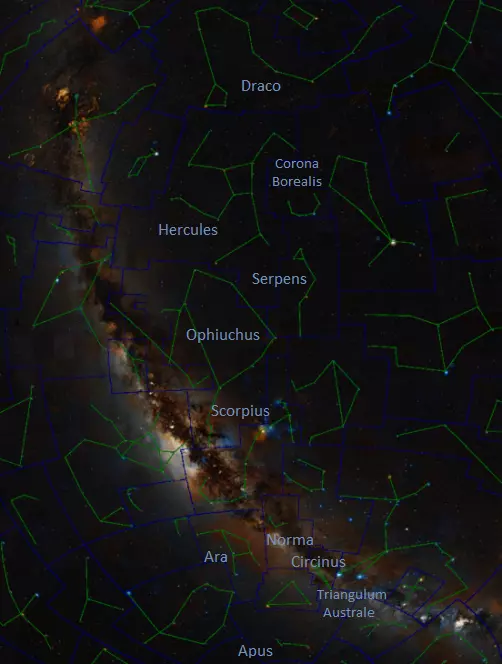
July constellations, image: Wikisky
Apus is invisible to all northern observers except those living in equatorial latitudes, while Ara and Triangulum Australe cannot be seen from locations north of tropical latitudes (25°N). Norma and Circinus cannot be seen north of latitude 30°N and Scorpius is visible from mid-northern latitudes (40°N), but never rises very high above the southern horizon.
The northernmost of the July constellations, Draco and Hercules, are the 8th and 5th largest constellations in the sky.
Representing the dragon from the myth of Hercules, Draco is large and quite visible on a clear night, but it is not particularly conspicuous, as its brightest star, Eltanin (Gamma Draconis) has an apparent magnitude of 2.24.
The constellation contains a number of notable deep sky objects. The best known ones are the Spindle Galaxy (NGC 5866), the Tadpole Galaxy (Arp 188), and the Cat’s Eye Nebula (NGC 6543). The Spindle Galaxy is a bright (mag. 10.7) lenticular (or possibly spiral) galaxy believed to be the object Charles Messier entered in his catalogue as Messier 102. The galaxy has an unusual extended dust disk which appears edge-on.
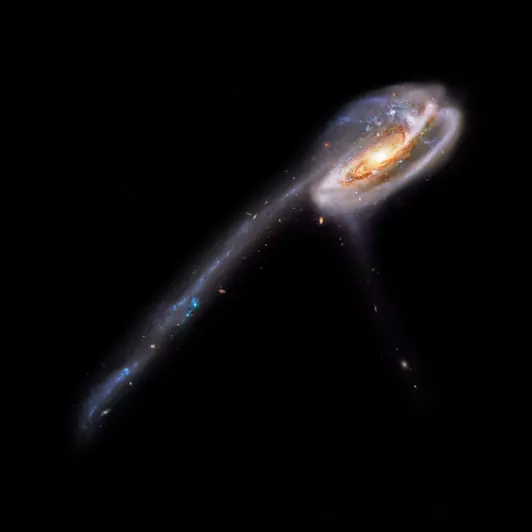
The Tadpole Galaxy recorded with the Hubble Space Telescope’s Advanced Camera for Surveys. Image processed and rendered by by Pablo Carlos Budassi (CC BY-SA 4.0)
The Tadpole Galaxy is a barred spiral galaxy known for its striking trail of stars that extends over about 280,000 light years, giving the galaxy the appearance of a tadpole. The massive trail of stars is the result of an interaction with a smaller galaxy.
The Cat’s Eye Nebula is a planetary nebula with a highly intricate structure and high surface brightness. It was the first object of its kind to be studied by English astronomer William Huggins, who investigated the nebula’s spectrum and was the first to demonstrate the difference between nebulae and galaxies.
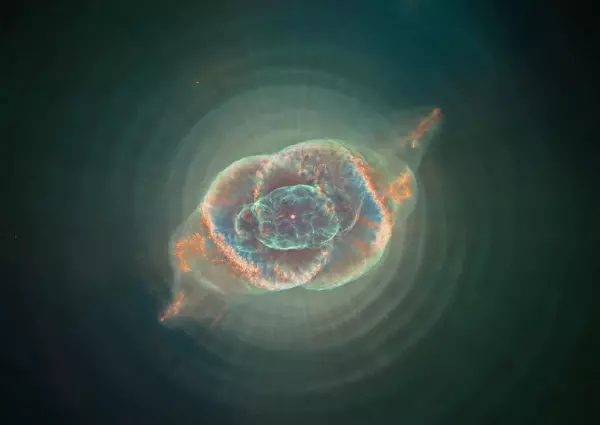
Staring across interstellar space, the alluring Cat’s Eye Nebula lies 3,000 light-years from Earth. The Cat’s Eye (NGC 6543) represents a brief, yet glorious, phase in the life of a sun-like star. This nebula’s dying central star may have produced the simple, outer pattern of dusty concentric shells by shrugging off outer layers in a series of regular convulsions. But the formation of the beautiful, more complex inner structures is not well understood. Here, Hubble Space Telescope archival image data have been reprocessed to create another look at the cosmic cat’s eye. Compared to well-known Hubble pictures, the alternative processing strives to sharpen and improve the visibility of details in light and dark areas of the nebula and also applies a more complex color palette. Of course, gazing into the Cat’s Eye, astronomers may well be seeing the fate of our sun, destined to enter its own planetary nebula phase of evolution … in about 5 billion years. Image: Hubble Space Telescope
Draco is also home to Abell 2218, a cluster of galaxies that acts as a powerful gravitational lens for a number of galaxies located beyond it. The background galaxies appear stretched along the core of the cluster and some of them are lensed multiple times.
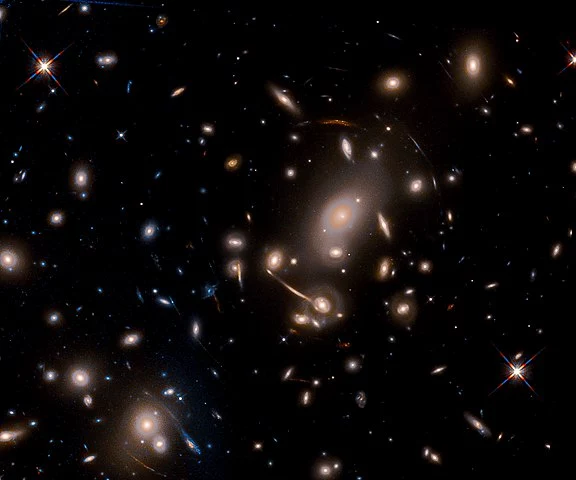
Abell 2218, image: NASA/ESA/Kevin M. Gill
Like Draco, Hercules does not have any first magnitude stars. Its brightest star, Kornephoros (Beta Herculis), has a visual magnitude of 2.78. Several other stars in the constellation – Pi, Eta, Zeta and Epsilon Herculis – form an asterism known as the Keystone, a relatively large quadrangle that represents Hercules’ torso. The Keystone is located between the bright star Vega in Lyra constellation and the stars of Corona Borealis, the Northern Crown.
Hercules contains two Messier objects, the globular clusters Messier 13 and Messier 92. Both these clusters are quite bright. Messier 13, known as the Hercules Globular Cluster, is in fact the brightest object of its kind in the northern sky. It has an apparent magnitude of 5.8 and is easy to find as it is located between Eta and Zeta Herculis, the stars that form the vertices of the Keystone on the side closer to Corona Borealis. Messier 92 is somewhat dimmer at magnitude 6.3, but in terms of absolute magnitude, it is one of the brightest globular clusters in the Milky Way.
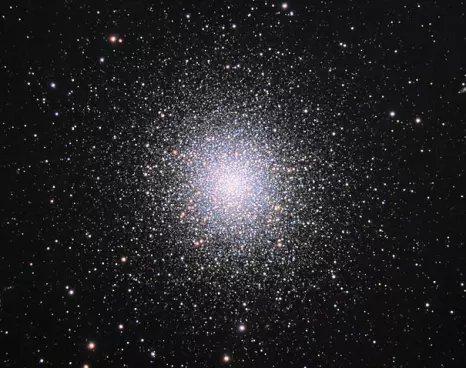
Hercules Globular Cluster (Messier 13), image: Wikimedia Commons/Astrowimp (CC BY-SA 4.0)
Hercules is also home to the Turtle Nebula (NGC 6210), a planetary nebula with a striking, unusual appearance, the active galaxy Hercules A, notable for its enormous plasma jets, the Hercules Cluster of galaxies (Abell 2151), whose brightest member is the giant elliptical galaxy NGC 6041, and the galaxy cluster Abell 2199, whose most prominent member is the supermassive elliptical galaxy NGC 6166, one of the most luminous galaxies in X-ray wavelengths, notable for its large halo of stars.
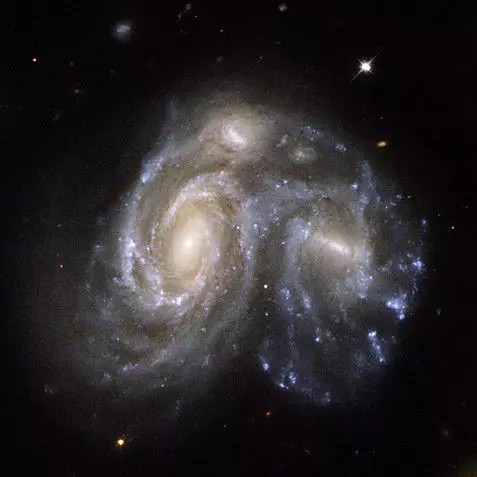
NGC 6050/IC 1179 (Arp 272) is a remarkable collision between two spiral galaxies, NGC 6050 and IC 1179, and is part of the Hercules Galaxy Cluster, located in the constellation of Hercules. The galaxy cluster is part of the Great Wall of clusters and superclusters, the largest known structure in the universe. The two spiral galaxies are linked by their swirling arms. Arp 272 is located some 450 million light-years away from Earth and is the number 272 in Arp’s Atlas of Peculiar Galaxies. This image is part of a large collection of 59 images of merging galaxies taken by the Hubble Space Telescope and released on the occasion of its 18th anniversary on 24th April 2008. Image: NASA, ESA, the Hubble Heritage (STScI/AURA)-ESA/Hubble Collaboration, and K. Noll (STScI)
Corona Borealis, the Northern Crown, is a small but recognizable constellation located between the Keystone in Hercules and the Kite, the pattern that dominates the Boötes constellation. The brightest star in Corona Borealis, Alphecca (Alpha Coronae Borealis) has an apparent magnitude of 2.23. It is one of the seven stars that form the constellation’s semicircular, crown-shaped pattern. The other six stars are fourth magnitude.
Corona Borealis contains two well-known variable stars. T Coronae Borealis, also known as the Blaze Star, is a recurrent nova, one of only 10 discovered in our galaxy. R Coronae Borealis, nicknamed the Fade-Out Star, is a prototype of class of stars known as the R Coronae Borealis (RCB) variables. It is a yellow supergiant that fades by several magnitudes as it gets obscured by the dust it has ejected, and then gradually returns to its regular brightness over a period of several months.
Corona Borealis does not have many deep sky objects that can be seen in amateur telescopes, but it is home to a significant number of galaxy clusters. The spiral galaxy NGC 6085 (mag. 14.5) and massive elliptical galaxy NGC 6086 (mag. 12.7) are members of the galaxy cluster Abell 2162, which is a member of the Hercules Superclusters, a set of two exceptionally large galaxy superclusters. The Corona Borealis Supercluster is the most prominent cluster of galaxies in the northern sky, containing a number of galaxy clusters, some of which are gravitationally bound and will eventually form a single massive cluster.
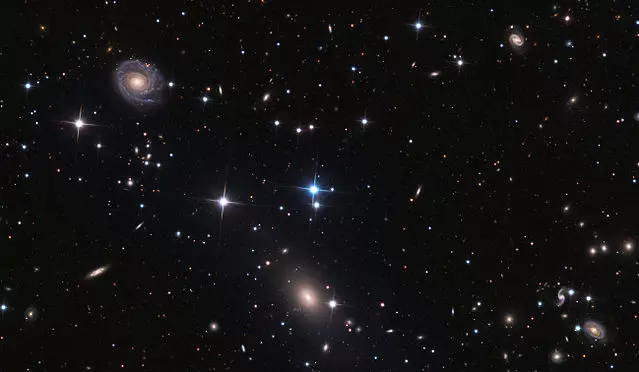
The galaxies NGC 6085 and NGC 6806, image: Adam Block/Mount Lemmon SkyCenter/University of Arizona (CC BY-SA 3.0 US)
South of Hercules and Corona Borealis, the constellations Ophiuchus and Serpens represent the snake bearer (usually identified as the mythical healer Asclepius) and a giant snake. The constellation Serpens is divided into two parts by Ophiuchus: Serpens Caput, the serpent’s head, and Serpens Cauda, the serpent’s tail.
Ophiuchus is the larger and brighter of the two constellations. It is the 11th largest constellation in the sky and has five stars brighter than magnitude 3.00. Its brightest star, Rasalhague (Alpha Ophiuchi), has an apparent magnitude of 2.08. Serpens, on the other hand, has only one star brighter than magnitude 3.00: Unukalhai (Alpha Serpentis), an orange giant with a visual magnitude of 2.6.
Ophiuchus is also home to Barnard’s Star, the fourth nearest individual star to the solar system. The red dwarf is only 5.9 light years distant from Earth.
Both constellations are rich with interesting deep sky objects. Ophiuchus contains seven Messier objects: the globular clusters Messier 9, Messier 10, Messier 12, Messier 14, Messier 19, Messier 62 and Messier 107. It is also home to Kepler’s Supernova (SN 1604), the remnant of the most recent supernova in the Milky Way that was visible to the unaided eye. At its peak, the supernova had an apparent magnitude of -2.5. It was brighter than any star and could be seen during the day for several weeks.
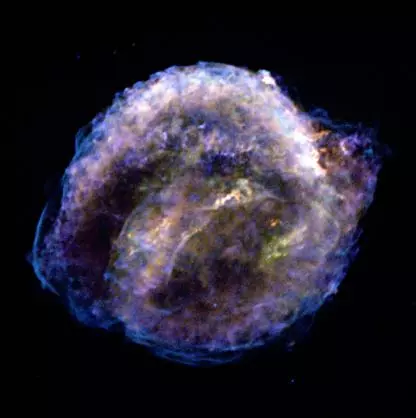
Kepler’s Supernova (Supernova 1604) – Using NASA’s Chandra X-ray Observatory, scientists have created a stunning new image of one of the youngest supernova remnants in the galaxy. This new view of the debris of a star helps astronomers solve a long-standing mystery, with implications for understanding how a star’s life can end dramatically and for gauging the expansion of the universe. Image: NASA
Other notable deep sky objects in Ophiuchus include the ultraluminous infrared galaxy NGC 6240, the large dark nebulae Barnard 68 and the Dark Horse Nebula, and the planetary nebulae NGC 6572, the Little Ghost Nebula (NGC 6369) and the Twin Jet Nebula, also known as Minkowski’s Butterfly.
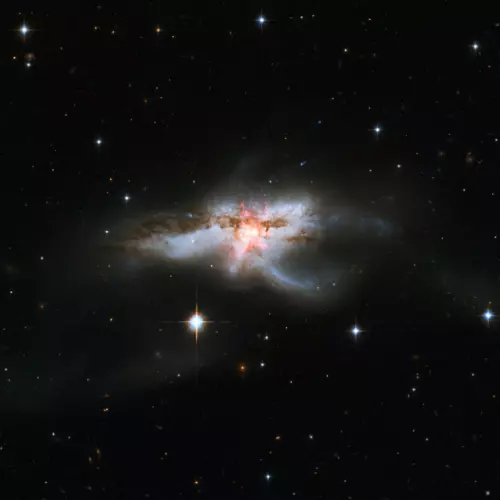
Not all galaxies are neatly shaped, as this new NASA/ESA Hubble Space Telescope image of NGC 6240 clearly demonstrates. Hubble previously released an image of this galaxy back in 2008, but the knotted region, shown here in a pinky-red hue at the centre of the galaxies, was only revealed in these new observations from Hubble’s Wide Field Camera 3 and Advanced Camera for Surveys. NGC 6240 lies 400 million light-years away in the constellation of Ophiuchus (The Serpent Holder). This galaxy has an elongated shape with branching wisps, loops and tails. This mess of gas, dust and stars bears more than a passing resemblance to a butterfly and, though perhaps less conventionally beautiful, a lobster. This bizarrely-shaped galaxy did not begin its life looking like this; its distorted appearance is a result of a galactic merger that occurred when two galaxies drifted too close to one another. This merger sparked bursts of new star formation and triggered many hot young stars to go out as supernovae. A new supernova was discovered in this galaxy in 2013, named SN 2013dc. It is not visible in this image, but its location is indicated here. At the centre of NGC 6240 an even more interesting phenomenon is taking place. When the two galaxies came together, their central black holes did so too. There are two supermassive black holes within this jumble, spiralling closer and closer to one another. They are currently only some 3000 light-years apart, incredibly close given that the galaxy itself spans 300 000 light-years. This proximity secures their fate as they are now too close to escape each other and will soon form a single immense black hole. Image: NASA, ESA, the Hubble Heritage (STScI/AURA)-ESA/Hubble Collaboration, and A. Evans (University of Virginia, Charlottesville/NRAO/Stony Brook University)
Serpens contains two Messier objects: the globular cluster Messier 5 and the Eagle Nebula (Messier 16), a large star-forming region famous for the three large pillars of gas nicknamed the Pillars of Creation, that were photographed by the Hubble Space Telescope in 1995. Other interesting deep sky objects in the constellation include Hoag’s Object, a famous ring galaxy, Seyfert’s Sextet, a group of colliding galaxies, and the Red Square Nebula, a bipolar nebula known for its square shape and unusual symmetry.
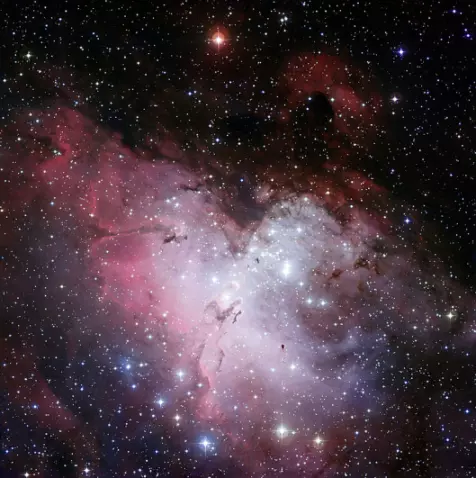
This is a three-colour composite mosaic image of the Eagle Nebula (Messier 16, or NGC 6611), based on images obtained with the Wide-Field Imager camera on the MPG/ESO 2.2-metre telescope at the La Silla Observatory. At the centre, the so-called “Pillars of Creation” can be seen. This wide-field image shows not only the central pillars, but also several others in the same star-forming region, as well as a huge number of stars in front of, in, or behind the Eagle Nebula. The cluster of bright stars to the upper right is NGC 6611, home to the massive and hot stars that illuminate the pillars. The “Spire” — another large pillar — is in the middle left of the image. Image: ESO
Located south of Ophiuchus, Scorpius is one of the brightest and most distinctive constellations in the southern sky. With 13 stars brighter than magnitude 3.00 and a recognizable pattern representing the scorpion’s stinger dominating the constellation, Scorpius is very easy to find. Its brightest star, the red supergiant Antares (Alpha Scorpii) is the 15th brightest star in the sky. It marks the heart of the scorpion and is also known as Cor Scorpii. Antares appears distinctly red to the unaided eye. It is classified as a slow irregular variable and its brightness changes from magnitude 0.6 to 1.6.
Other bright stars in Scorpius include Shaula (Lambda Scorpii), the second brightest star in the constellation and the 23rd brightest star in the sky and Sargas (Theta Scorpii), the 37th brightest star. These two stars are part of an asterism that represents the scorpion’s tail.
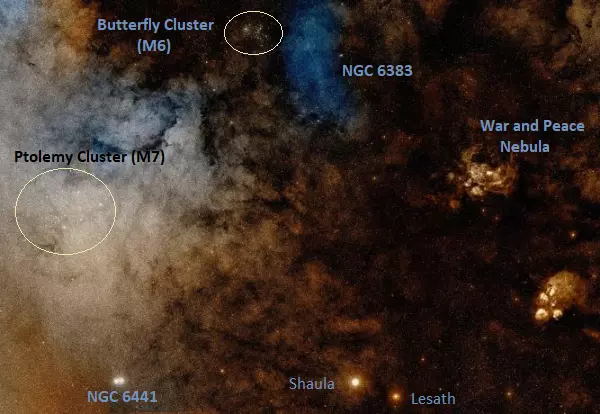
Deep sky objects in Scorpius, image: Wikisky
Scorpius is home to four Messier objects: the bright globular clusters Messier 4 and Messier 80, and the famous open clusters Messier 6, also known as the Butterfly Cluster, and Messier 7, Ptolemy’s Cluster. The latter two are best observed in binoculars and both lie in the vicinity of Shaula and the scorpion’s stinger.
Scorpius contains a number of other notable deep sky objects, among them Cat’s Paw Nebula (NGC 6334), the Butterfly Nebula (NGC 6302) and the Lobster Nebula (NGC 6357), sometimes also known as the War and Peace Nebula. The Cat’s Paw Nebula is a large star forming emission nebula named for its resemblance to a cat’s paw. It is sometimes also known as the Bear Claw Nebula. The Butterfly (or Bug) Nebula is a bipolar planetary nebula with a highly complex structure, illuminated by one of the hottest stars in the Milky Way. The War and Peace Nebula is a diffuse nebula notable for its striking appearance, with one part resembling a skull and the other a dove in infrared images.
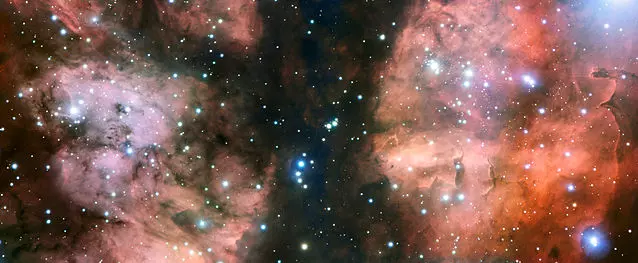
War and Peace Nebula – ESO’s Very Large Telescope (VLT) has taken the most detailed image so far of a spectacular part of the stellar nursery called NGC 6357. The view shows many hot young stars, glowing clouds of gas and weird dust formations sculpted by ultraviolet radiation and stellar winds. Image: ESO
The constellations Norma and Circinus are both small and faint, with no stars brighter than magnitude 4.00 except for one, Alpha Circini (mag. 3.19). Norma is located between the larger and brighter Scorpius and Centaurus, while Circinus, the fourth smallest of all constellations, was created to fill the gap between Triangulum Australe and the stars representing Centaurus’ forefeet, the Southern Pointers Alpha and Beta Centauri.
Interesting objects in Norma include eight open star clusters that can be observed in binoculars, the Norma Cluster, one of the most massive galaxy clusters ever discovered, the Ant Nebula (Mz 3), a bipolar planetary nebula with a prominent central ring, and the Fine Ring Nebula (Shapley 1), an annular planetary nebula with an unusual ring structure.
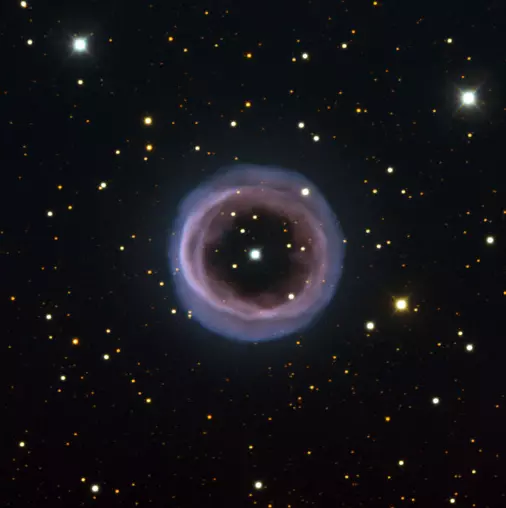
The hazy and aptly named Fine Ring Nebula, shown here, is an unusual planetary nebula. Planetary nebulae form when some stars in their final stages, having expanded into a red giant phase, expel a shell of gas as they evolve into white dwarfs. Most planetary nebulae are either spherical or elliptical in shape, or bipolar (featuring two symmetric lobes of material). But the Fine Ring Nebula — captured here by the ESO Faint Object Spectrograph and Camera mounted on the New Technology Telescope at the La Silla Observatory in Chile — looks like an almost perfect circular ring. Astronomers believe that some of these more unusually shaped planetary nebulae are formed when the progenitor star is actually a binary system. The interaction between the primary star and its orbiting companion shapes the ejected material. The stellar object at the centre of the Fine Ring Nebula is indeed thought to be a binary system, orbiting with a period of 2.9 days. Observations suggest that the binary pair is almost perfectly face-on from our vantage point, implying that the planetary nebula’s structure is aligned in the same way. We are looking down on a torus (doughnut shape) of ejected material, leading to the strikingly circular ring shape in the image. Image: ESO
Circinus contains NGC 5823, an open cluster near the border with the constellation Lupus, the planetary nebula NGC 5315, visible only in larger telescopes near Alpha Circini, and the Circinus Galaxy (ESO 97-G13), one of the nearest galaxies to the Milky Way, classified as a Type II Seyfert galaxy.
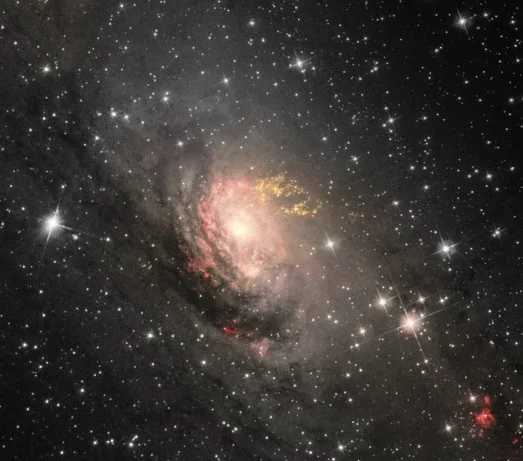
Circinus Galaxy (ESO 97-G13), image: Judy Schmidt (CC BY 2.0)
Ara, the Altar, is located between Scorpius and Triangulum Australe. The constellation’s brightest stars are Beta Arae, an orange supergiant or bright giant with an apparent magnitude of 2.84, and Alpha Arae, a massive blue-white main sequence star with a visual magnitude of 2.93.
Notable deep sky objects in Ara include the bright open cluster NGC 6193 (mag. 5.0), the Ara Cluster (Westerlund 1), one of the most massive young star clusters in the Milky Way, which contains Westerlund 1-26, one of the largest stars known, the globular clusters NGC 6352, NGC 6362 and NGC 6397, the last of which is visible to the unaided eye under clear, dark skies, and the planetary nebulae NGC 6326 and the Stingray Nebula. The Stingray Nebula was the youngest known planetary nebula at the time of discovery; it was first observable in 1987.
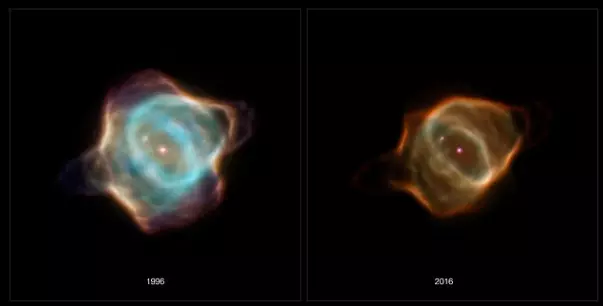
Archival data from the NASA/ESA Hubble Space Telescope reveal that the nebula Hen 3-1357, nicknamed the Stingray nebula, has faded precipitously over just the past two decades. Witnessing such a swift rate of change in a planetary nebula is exceedingly rare, say researchers. These images captured by Hubble in 1996 (left), when compared to Hubble images taken in 2016 (right), show a nebula that has drastically dimmed in brightness and changed shape. Bright blue shells of gas near the centre of the nebula have all but disappeared, and the wavy edges that earned this nebula its aquatic-themed name are virtually gone. The young nebula no longer pops against the black velvet background of the distant Universe. Image: NASA, ESA, B. Balick (University of Washington), M. Guerrero (Instituto de Astrofísica de Andalucía), and G. Ramos-Larios (Universidad de Guadalajara)
Triangulum Australe is one of the smallest constellations, 83rd in size, occupying an area of only 110 square degrees. It lies near the bright stars Alpha and Beta Centauri. As the name (Southern Triangle) suggests, the constellation’s three brightest stars – the orange giant Atria, Alpha Trianguli Australis (mag. 1.91) and white main sequence stars Beta (mag. 2.85) and Gamma Trianguli Australis (mag.2.87) – form an almost equilateral triangle.
The constellation has very few bright deep sky objects. They include the mag. 5.1 open cluster NGC 6025, the colliding pair of galaxies ESO 69-6, and the planetary nebula NGC 5979.
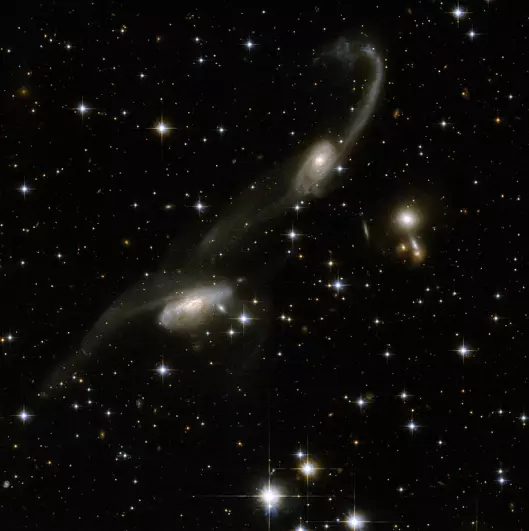
ESO 69-6 – The galaxies of this beautiful interacting pair bear some resemblance to musical notes on a stave. Long tidal tails sweep out from the two galaxies: gas and stars were stripped out and torn away from the outer regions of the galaxies. The presence of these tails is the unique signature of an interaction. ESO 69-6 is located in the constellation of Triangulum Australe, the Southern Triangle, about 650 million light-years away from Earth. Image: NASA, ESA, the Hubble Heritage (STScI, AURA)-ESA, Hubble Collaboration, and A. Evans (University of Virginia, Charlottesville, NRAO, Stony Brook University)
Apus, the southernmost of the July constellations, represents the bird-of-paradise. Its five brightest stars – none of them brighter than magnitude 3.00 – are all reddish in hue. The constellation contains two notable globular clusters. NGC 6101 is about 160 light years across and has an apparent magnitude of 9.2. It is notable for having a high concentration of blue stragglers, massive, luminous blue stars that appear much younger than they really are, likely as a result of collisions between the stars in the cluster. IC 4499 is a loose globular cluster with a visual magnitude of 9.76. It is the nearest globular cluster to the south celestial pole. Apus is also home to several faint galaxies, including the spiral galaxies IC 4633 and NGC 6392.
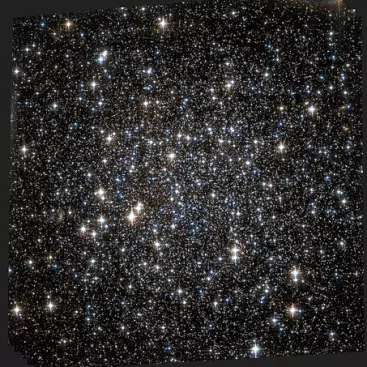
NGC 6101, image: NASA (Hubble Space Telescope)
The table below shows the latitudes between which the constellations are visible.
| Constellation | Northern latitude | Southern latitude |
| Apus | 5° | 90° |
| Ara | 25° | 90° |
| Circinus | 30° | 90° |
| Corona Borealis | 90° | 50° |
| Draco | 90° | 15° |
| Hercules | 90° | 50° |
| Norma | 30° | 90° |
| Ophiuchus | 80° | 80° |
| Scorpius | 40° | 90° |
| Serpens | 80° | 80° |
| Triangulum Australe | 25° | 90° |